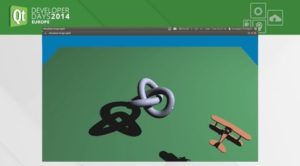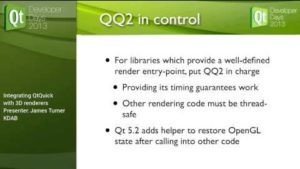Good news, everyone! Qt 5.5 has just been released! The release process of Qt 5.5 has been focused on stabilizing and improving performances. Once more KDAB is proud to be a part of the release, with its engineers constantly providing contributions and patches, as demonstrated by the commit graph of the last 16 weeks: In […]
Qt3D Get the RSS Feed
Qt 3D Technology Preview Released with Qt 5.5.0
KDAB is pleased to announce that the Qt 5.5.0 release includes a Technology Preview of the Qt3D module. Qt3D provides a high-level framework to allow developers to easily add 3D content to Qt applications using either QML or C++ APIs. The Qt3D module is released with the Technology Preview status. This means that Qt3D will […]
Introducing Qt3D 2.0
Integrating QtQuick 2 with 3D renderers
Abstract: “QtQuick in Qt5 uses OpenGL to deliver fluid, performant visuals, and an internal scene-graph structure to permit threaded rendering, decoupling the main application thread from interacting directly with the graphics driver. For developers work with an existing rendering or visualisation technology, this presents both an opportunity but also problems; QtQuick offers a compelling, modern […]
KDAB joins Khronos and welcomes Vulkan for next generation graphics
We are proud to announce that KDAB is now a contributor member of the Khronos Group, a not for profit, member-funded consortium focused on the creation of royalty-free open standards for parallel computing, graphics and dynamic media on a wide variety of platforms and devices. As a contributor member of the Khronos Group, KDAB is […]
Qt3D 2.0 The FrameGraph
Continuing our blog post series about the rewrite of Qt3D. Introduction For quite some time now, you’ve been hearing about Qt3D’s Framegraph. Although a brief definition of what the Framegraph is was given in the previous articles, this blog post will cover it in more detail. After reading this post, you will understand the difference […]
Shadow Mapping in Qt3D 2.0
Continuing our blog post series about the rewrite of Qt3D. One of the biggest driving factors behind the design of Qt3D 2.0 is the ability to configure the renderer in order to accommodate custom rendering techniques. In this blog post I will explain how to render a scene in Qt3D with shadows.
Overview of Qt3D 2.0 – Part 2
An Example of Rendering with Qt3D In the previous article we learned about the requirements and high-level architecture of Qt3D 2.0. In order to put some of this into context and to give you a concrete example of how it looks to draw something in Qt3D using the QML API, we will now briefly show […]
Overview of Qt 3D 2.0 – Part 1
by Sean Harmer of KDAB Back in the days when Qt was owned by Nokia, a development team in Brisbane had the idea of making it easy to incorporate 3D content into Qt applications. This happened around the time of the introduction of the QML language and technology stack, and so it was only natural […]
Overview of Qt3D 2.0 – Part 1
Introduction Back in the days when Qt was owned by Nokia, a development team in Brisbane had the idea of making it easy to incorporate 3D content into Qt applications. This happened around the time of the introduction of the QML language and technology stack, and so it was only natural that Qt3D should also […]

